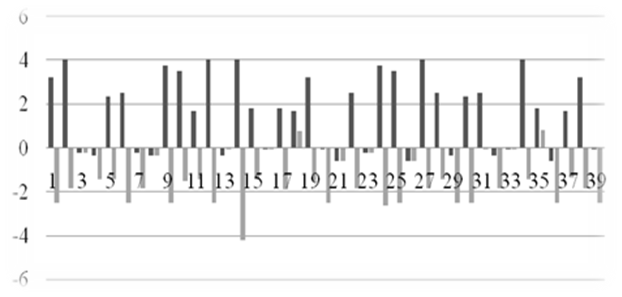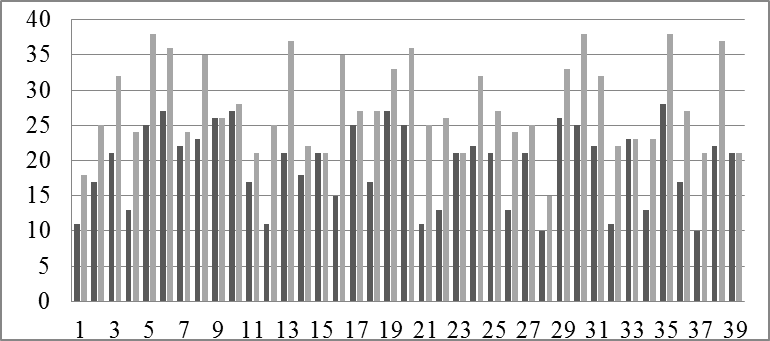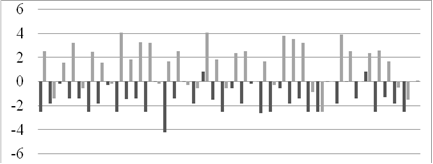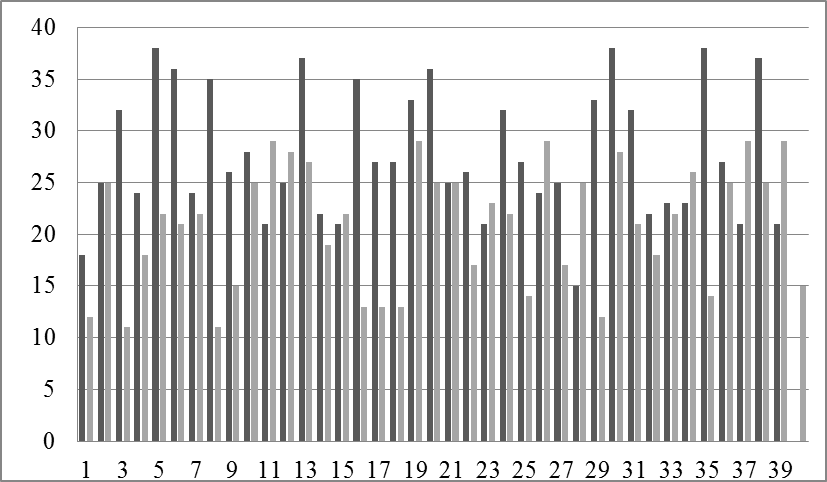Abstract
The article focuses on developing future Social work specialists’ interethnic tolerance. Since the development of interethnic tolerance takes place throughout the life of an individual and depends on the age characteristics of university students, the authors question if interethnic tolerance can be developed between the ages of 18 and 21. As a means of its formation, we suggest using non-violent communication among students, which performs as the basis of productive interaction between social work specialists and their clients, and as a conflict resolution technique that allows participants to understand and cater for the wishes and peculiarities of communicators. In non-violent communication, there is no negative attitude towards interlocutors, combined with tolerance for unfamiliar aspects of other cultures or ways of life, as well as readiness and possibility to interact effectively without conflict with representatives of various nations or ethnicities. The authors also justify that a specially developed programme might be used to successfully develop interethnic tolerance of future specialists in Social work by the means of non-violent communication. In addition, based on qualitative and quantitative methods of the experimental study data we prove that non-violent communication in the “teacher-student” interaction pattern has a positive impact on forming interethnic tolerance of students.
Keywords: Social workinterethnic tolerancenon-violent communication
Introduction
Peaceful co-existence and effective interaction between people of different nationalities is a problem that many philosophers, politicians, psychologists, sociologists and teachers are concerned about. Globalization and worldwide integration of economies and cultures make it a priority for countries to create the environment free of sectarian, racial and ethnic conflicts. Nowadays, when moral values are blurring, society is becoming less homogeneous, and there are conflicts between different ethnic groups accompanied with migration processes, the search for efficient methods and means of developing interethnic tolerance becomes more relevant. Interethnic tolerance is a fundamental principle of social relations in a civilized society and a means of harmonizing inter-ethnic relations. Some researchers ( Bowers & Moffett, 2012; Ivkova, 2006) emphasize the importance of raising ethnicity awareness, recognizing the equality of ethnic groups and accepting their peculiarities. In our opinion, this is especially important for ‘assisting professions’ such as teachers, psychologists, social work specialists.
Problem Statement
The Russian Federation, as a country with a complex ethnic structure, throughout its history has adhered to the principles of domestic policy based on respect for the rights, freedoms and traditions of all ethnic groups living in its territory. The issue of interaction between indigenous peoples and representatives of other nations is now relevant due to the changed ethnic social situation, the inflow of refugees and migrants, which highlights the need to develop interethnic tolerance among future social workers. This need is also caused by the existing contradiction between the social order of the society, the demand from the educational practitioners and the insufficient development of pedagogical theory and methodology for the development of interethnic tolerance of students.
People’s behaviour, based on tolerant attitudes, is not an inherent characteristic. Modern research confirms that interethnic tolerance is acquired, not through imposing, but through purposeful educating and personal life experience. The active formation of interethnic tolerance begins in adolescence and continues in the period of youth thanks to the self-awareness developed in teenage years. In this regard, the problem of developing interethnic tolerance is relevant for organizations not only of general but also of higher professional or vocational education. Taking into account the interethnic tension, efforts to nurture interethnic tolerance among university students should become one of the primary aims of education.
One of the means of developing interethnic tolerance, in our opinion, can be non-violent communication. Being a method of humanistic psychology ( Maslow, 1943; Rosenberg, 2003), non-violent communication allows people to increase efficiency of work with students of ‘assisting professions’ and to achieve better results in improving intolerant attitudes.
Research Questions
-
Is it possible to correct intolerant attitudes and to increase the level of interethnic tolerance at the age of 18-21? -
Does non-violent communication used in the educational process of the university contribute to the formation of interethnic tolerance of future specialists in Social work? -
Can a specially designed educational programme perform as a condition to develop interethnic tolerance in students through non-violent communication?
Purpose of the Study
The purpose of this study is to identify and justify the possibilities of a specially designed program as a condition to develop of interethnic tolerance of future specialists in Social work through non-violent communication.
The study addresses a number of interrelated tasks:
to overview the theoretical foundations of the problem of developing interethnic tolerance of students - future specialists in Social work through non-violent communication;
to develop and test a syllabus aimed at building interethnic tolerance among students through non-violent communication;
to evaluate the effectiveness of the implemented programme.
Research Methods
A number of interrelated methods have been used to achieve the main objectives of the study.
Theoretical analysis and overview of psychological and pedagogical academic papers
The analysis of scientific resources led us to understand interethnic tolerance as a person's ability to tolerate the unfamiliar way of life of some members of other ethnic communities, their behaviour, national traditions, customs, feelings, opinions, ideas, beliefs, etc. ( Jones, 2009; Krysko, 2003). The interethnic tolerance in such an interpretation will be the self-control of the individual in situations when they join a new ethnic group and interact with them.
The structure of interethnic tolerance is identical to that of any other tolerance, and includes three interrelated components:
cognitive – the knowledge about tolerance and perceptions of other ethnic groups, their customs, tradition, basic stereotypes, identification with their ethnicity;
emotional - the relationships with other ethnic groups, positive attitude to information about other cultures, readiness for humane, sensitive attitude towards people regardless of their ethnicity, acceptance and satisfaction with interpersonal interaction with them;
behavioural – a complex of specific acts of behaviour, desire for joint constructive activities, positive interaction with respect to representatives of other nationalities, desire for cooperation, assistance and support ( Ivkova, 2006).
Traditionally, three levels of inter-ethnic tolerance are identified:
Low level – when positive ethnic identification is combined with ethno-fanaticism; when there is an average level of civil identity or lack of interest in it; when high or medium social distance in relation to representatives of other nationalities is observed. In our research students generally place themselves to a higher position compared with the low rate of "typical representatives" of their own nationality and even negative rate of representatives of "alien" nationalities.
Medium level – when people have their own positive ethnic identification and medium level of their civil identity, as well as medium social distance in relation to members of other nationalities. Students are characterized by a positive assessment of themselves, of "typical representatives" of their own and "alien" nationalities. However, students rate other nationalities at a lower level than they rate themselves.
High level – when people have positive ethnic and civil identity, close social distance to members of other nationalities; positive self-esteem, as well as positive attitude towards "typical representatives" of their own and "alien" nationalities.
While searching for conditions and means of organizing the development of interethnic tolerance among university students, we highlighted the main principles:
Youth period is sensitive for the formation of interethnic tolerance.
Communication is still the leading activity of young people and it affects its intellectual development.
The movement of world pedagogy towards non-violence and recognition of non-violence as universal human value make the techniques of non-violent communication important to be developed.
Non-violent communication is the basis of productive interaction between specialists of ‘assisting professions’ (including specialists in Social work) and their ‘clients’, which allows understanding the wishes and peculiarities of all participants of communication.
Interethnic tolerance has features that also characterize non-violent communication.
Research methods: questionnaires and testing
Tests and questionnaires were used to perform primary and final research checking. They were carried out using the following assessment tools: “Measurement of tolerant attitudes in the area of interethnic relations” survey ( Sobkin & Adamchuk, 2006); “Tolerance Index” questionnaire ( Soldatova, Kravtsova, & Khulaev, 2002). The questionnaire by Sobkin and Adamchuk ( 2006) contains 12 questions, the answers to which are presented in the form of judgements formulated in advance by the authors, each of which is an expression of the tolerant or intolerant attitude of a person towards representatives of other ethnicities. The overall score is calculated by summing up the indices in all 12 questions. This research tool does not assume to identify the levels. If the total index is negative, it means a certain degree of tolerance; if it is positive, it indicates a certain degree of intolerance, which makes it possible to draw conclusions about prevailing attitudes towards people of other nationalities.
“Tolerance Index” ( Soldatova et al., 2002) was used to determine the level of inter-ethnic tolerance development among university students. It contains 22 statements, and the respondents need to rate to what extent they agree or disagree with a certain statement by choosing one of the options. This questionnaire implies the division into sub-categories: ethnic tolerance, social tolerance and tolerance as the individual trait. Within this study, we used the results from the ethnic tolerance category.
Pedagogical experiment
The experimental study was carried out at the Vologda State University among students studying Social work. The study involved 87 students aged 18-21, 79 of whom were part of experimental and control groups. Based on the preliminary results from the questionnaires, we formed control and experimental groups from the students showing low and medium levels of inter-ethnic tolerance and insufficient level of tolerant attitudes. The control group included 40 people, and the experimental group included 39 students who wished to attend an optional course on non-violent communication. Mann-Whitney's U-test was used to prove the equivalence of both groups before the experiment. Then 20 sessions of 90 minutes each were conducted in the experimental group. Each session was held once a week. The sessions were based on the programme we designed for the experiment and involved two areas: 1) organising non-violent communication in teacher-students relationships; 2) acquiring the skill of non-violent communication.
Based on models of non-violent communication by Hippenreiter ( 2000), Latini ( 2009), Rosenberg ( 2003), Maralov and Sitarov ( 2016), we concentrated our efforts on developing students’ skills in the following areas: “Non-Violent Self-Attitude, “Sensitivity to People”, “Distinguishing between Observations and Judgements, “Unconditional Acceptance”, “Expression of Feelings, "Empathy”, “Active Listening”, “You-message and I-message”, “Confirmation of Needs”, “How to Express a Need, “Effective Ways to Resolve Conflicts”. During each class, students learned specific elements of non-violent communication techniques that contributed to the formation of one or more components of interethnic tolerance. After the implementation of the programme, we carried out a second testing in both experimental and control groups using the same methods as during the preliminary stage.
Statistical methods in the research
We used a number of mathematical and statistical methods to justify the effectiveness of the implemented programme of classes with university students. They are nonparametric Mann-Whitney U-test to compare two unrelated samples, parametric Wilcoxon T-test to compare indicators measured in two different conditions with the same sample of subjects.
Findings
Analysis of preliminary diagnostic results
During the preliminary testing in the control group the average value of tolerant attitudes was 1.69, while in the experimental group it was 1.67. These figures indicate more intolerant attitudes.
To confirm the equivalence of the two samples according to the level of formation of their tolerant attitudes, we applied the Mann-Whitney U-test. Uemp=783 was obtained at Ucg=611 (Uemp > Ucg, at p=0.05). Therefore, in this characteristic, the groups prior to the experiment are equivalent.
Preliminary testing of the control group showed that the average value of ethnic tolerance of teenagers is 19.62 points, while in the experimental group it was - 19.46. These indicators show a low level of formation of ethnic tolerance of university students in both groups. To confirm the equivalence of the two samples according to the level of their ethnic tolerance, we also applied the Mann-Whitney U-test. As a result, Uemp=756.5 was obtained at Ucg=611, Uemp>Ucg at p=0.05. It can be concluded that the groups prior to the experiment are equivalent.
Analysis of post-experimental results
At the end of the programme implementation, we rechecked tolerant attitudes (Figure

We used the Wilcoxton T-test to determine the shifts. When comparing indicators of tolerant installations the Temp=45 is received at Tcg=271 (Temp<Tcg at р=0.05), when comparing indicators of level of interethnic tolerance - Temp=0 at Tcg=271 (Temp<Tcg at р=0.05). Consequently, there have been significant positive changes, both in tolerant attitudes and in the level of interethnic tolerance among students in the experimental group.

The control group was also re-diagnosed. We compared the indicators obtained in the experimental group after the experimental influence with the results obtained in the control group. In the control group, the average tolerance value is 1.34 and in the experimental group it is -1.51. This indicates intolerance in the control group and tolerance in the experimental group (Figure

We can assume that as a result of the experimental impact, there have been changes in tolerant attitudes among the students in the experimental group. Mann-Whitney U-test was used to justify this conclusion. The obtained data confirm significant differences in tolerant attitudes of students in control and experimental groups (Uemp = 161.5 while Ucg = 611, Uemp˂Ucg at р=0.05).
The second testing showed that in the control group the average value of the level of development of interethnic tolerance is 20.9 while in the experimental it is 27.69. The level of interethnic tolerance among the participants from experimental group is higher than the level of interethnic tolerance of the control group participants (Figure

Mann-Whitney U-test was used to justify the differences significance. The obtained data confirm the difference in indicators in the control and experimental groups: Uemp =434 while Ucg=611 (Uemp<Ucg at р=0.05).
Thus, using the Mann-Whitney U-test, we proved that the experimental and control groups are not equivalent after the experimental influence. This confirms that the formative experiment contributed to the increase in the level of interethnic tolerance of future specialists in Social work and changed their intolerant attitudes.
Conclusion
The study allowed us to draw several conclusions.
It is possible to change intolerant attitudes and increase of the level of interethnic tolerance among students at the age of 18-21. Non-violent communication, used in the educational process of the university in "teacher-students" relationships, can contribute to the formation of interethnic tolerance of future specialists in Social work. Specially designed educational programme can perform as a condition to successfully develop interethnic tolerance among students who are future specialists in Social work by using non-violent communication. The developed programme can be used to develop interethnic tolerance not only among future specialists in Social work, but also among university students acquiring any social-oriented professions. However, we admit that this claim requires further experimental study.
References
- Bowers, R., & Moffett, N. (2012). Empathy in Conflict Intervention: The Key to Successful. NVC Mediation. Harmony World Publishing.
- Hippenreiter, Y. B. (2000). Communicate with a child. How? Moscow: CheRo. [in Russ].
- Ivkova, Y. P. (2006). Formation of ethnic tolerance of high school students in the activity of the class tutor: PhD Thesis in Pedagogy. Petrozavodsk. [in Russ].
- Jones, S. (2009). Traditional Education or Partnership Education: Which Educational Approach Might Best Prepare Students for the Future? MA Thesis, Communication, San Diego, California. USA. San Diego University.
- Krysko, V. G. (2003). Handbook on Social Psychology. St. Petersburg: Peter. [In Russ.]
- Latini, T. (2009). Nonviolent Communication: A Humanizing Ecclesial and Educational Practice. Journal of Education & Christian Belief.
- Maralov, V. G., & Sitarov, V. A. (2016). Psychological and pedagogical conditions to form non-violent attitude towards other people. Knowledge. Understanding. Skills, 2, 246-258. [in Russ.]
- Maslow, A. H. (1943). A Theory of Human Motivation. Psychological Review, 50(4), 430-437.
- Rosenberg, M. (2003). Nonviolent Communication: A Language of Life. CA: Puddledancer Press.
- Sobkin, V. S., & Adamchuk, D. V. (2006). The study of tolerant attitude in the field of international relationships. Bulletin of Psychological Practice in Education, 2, 26–35. [in Russ]
- Soldatova, G. U., Kravtsova, O. A., & Khulaev, O. E. (2002). Tolerance Psychodiagnostics. Psychologists on migrants and migration in Russia Bulletin, 4, 59–65. [in Russ]
Copyright information

This work is licensed under a Creative Commons Attribution-NonCommercial-NoDerivatives 4.0 International License.
About this article
Publication Date
26 August 2020
Article Doi
eBook ISBN
978-1-80296-086-0
Publisher
European Publisher
Volume
87
Print ISBN (optional)
-
Edition Number
1st Edition
Pages
1-812
Subjects
Educational strategies, educational policy, teacher training, moral purpose of education, social purpose of education
Cite this article as:
Tikhomirova, E. L., & Shadrova, E. V. (2020). Developing Interethnic Tolerance Of Social Work Students By Non-Violent Communication. In S. Alexander Glebovich (Ed.), Pedagogical Education - History, Present Time, Perspectives, vol 87. European Proceedings of Social and Behavioural Sciences (pp. 476-483). European Publisher. https://doi.org/10.15405/epsbs.2020.08.02.62

